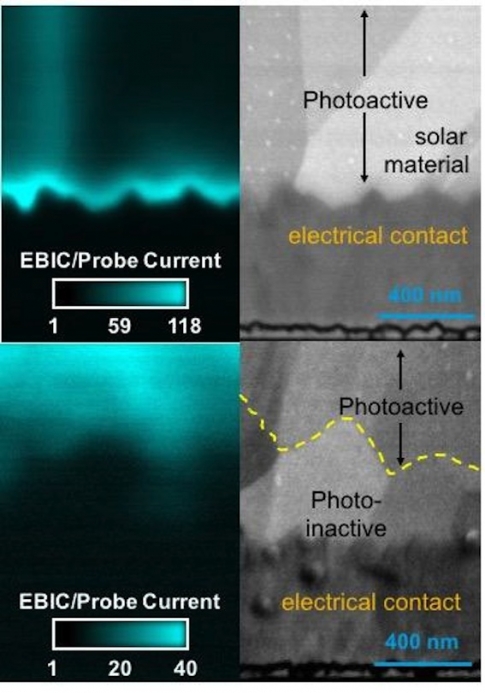DoE lab optimises CdTe recipe

Above: the entire solar material for the sample with less than or equal to 30 percent selenium is photoactive (top) while the bottom of the solar material for the image below contains greater than 35 percent selenium and has reduced photoactivity.
Solar cells based on cadmium and tellurium could move closer to theoretical levels of efficiency following investigations by researchers at the US Department of Energy's Oak Ridge National Laboratory.
A team led by Jonathan Poplawsky of the Center for Nanophase Materials Sciences used advanced microscopy techniques to discover efficiency differences of crystalline structures of various mixtures of cadmium, tellurium and selenium. The team's paper is published in Nature Communications.
While some of today's solar cells use a blend of cadmium and tellurium to convert light into electricity, adding the optimum amount of selenium in the right places could help increase efficiency from the current mark of about 22 percent to levels approaching the theoretical limit of 30-33 percent. The trick is to determine the best ratio of selenium.
"Using different microscopy methods, we were able to gain a better understanding of the phases, compositions and crystalline structures that allow these materials to convert light into electricity more efficiently," said Poplawsky, adding that the availability of data is limited. "In some instances, adding too much selenium changes the crystalline structure of cadmium-tellurium and dramatically reduces the conversion efficiency."
For this study, researchers studied four solar cells with different selenium contents - and corresponding changes in crystal structure - and learned that the one with the highest level of selenium did not perform well. Neither did the one with the lowest selenium content. The alloy composition that performed best consisted of approximately 50 percent cadmium, 25 percent tellurium and 25 percent selenium.
To make their determination, researchers used a combination of analytical techniques, including atom probe tomography, transmission electron microscopy and electron beam induced current. These are capabilities within the CNMS, a DOE Office of Science User Facility.
"We have shown that the amount of selenium incorporated into the cadmium-tellurium controls whether the small crystals inside the solar cell form as crystal structure A or crystal structure B," Poplawsky said. "This information can be used as a roadmap for solar cell producers to make improved CdTe solar cells that use selenium additions, and hopefully increase the overall efficiency."
Poplawsky noted that solar panels typically use silicon as the material for converting sunlight into electricity. CdTe, however, has an advantage over silicon because it can absorb the same amount of sunlight with 98 percent less semiconducting material, thus reducing the overall cost of the solar panel. This also makes solar panels composed of cadmium, tellurium and selenium more competitive with other forms of electricity generation.
The research was funded by DOE's SunShot Initiative in collaboration with the National Sciences Foundation.
'Structure and Compositional Dependence on the CdTexSe1-x Alloy Layer Photoactivity in CdTe-based Solar Cells', by Wei Guo et al; Nature Communications 7, Article number: 12537


































